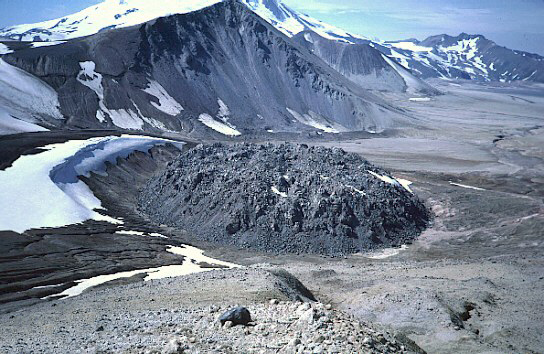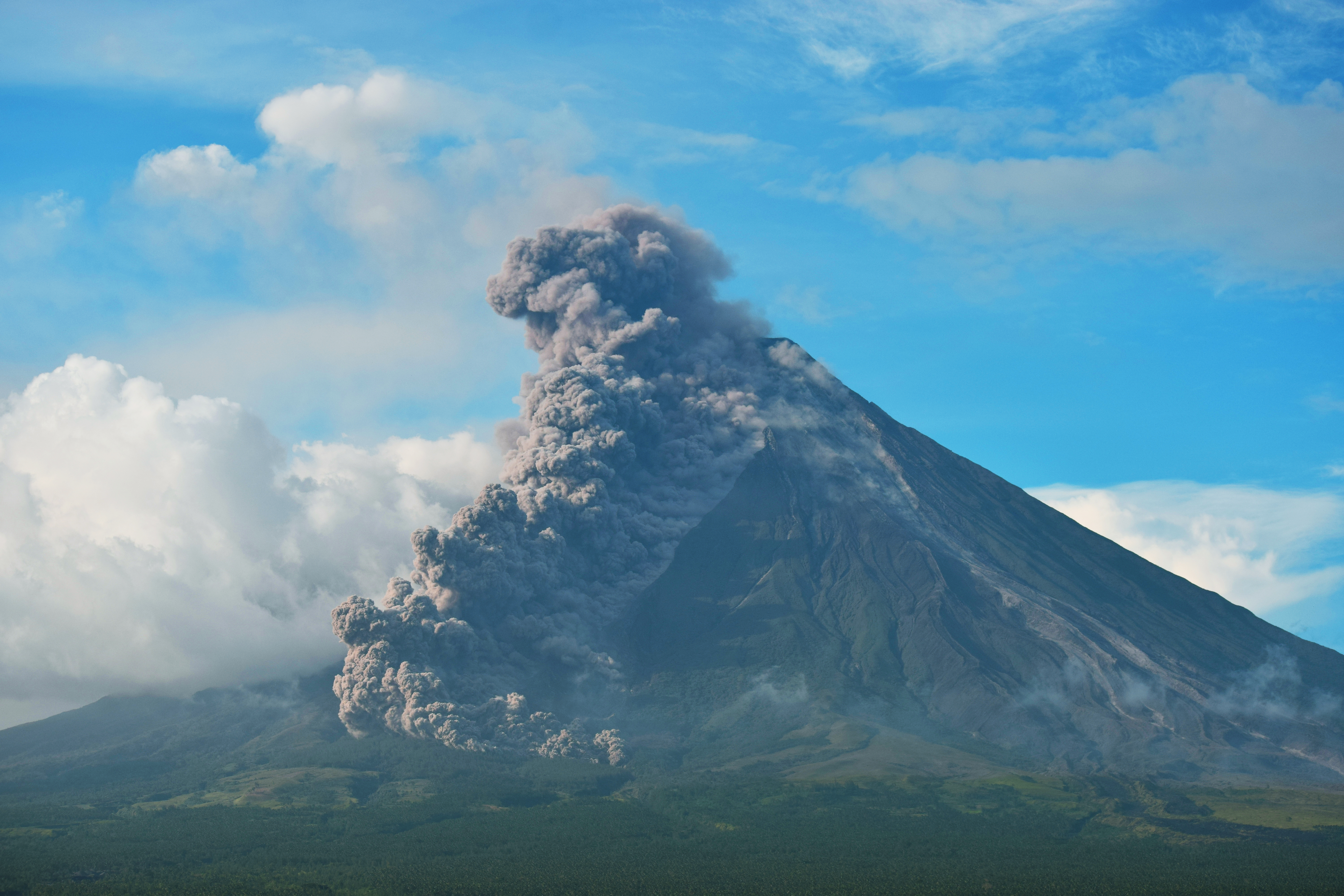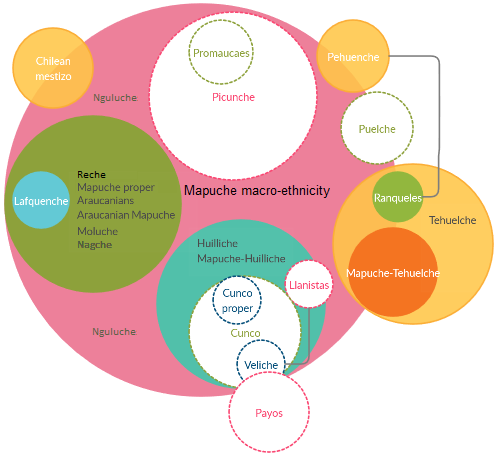|
Pillan Patera
Pillan Patera is a patera, or a complex crater with scalloped edges, on Jupiter's moon Io. It is located at , south of Pillan Mons and west of Reiden Patera. It is named after the Araucanian thunder, fire, and volcano god. Its name was approved by the International Astronomical Union in 1997. Pillan Patera is approximately 70 kilometers in diameter. In the summer of 1997, it erupted in an event now defined as "Pillanian" eruption style. At temperatures higher than 1,600 °C, (2912 °F) a 140 kilometer high plume eruption deposited dark pyroclastic materials rich in orthopyroxene over an area greater than 125,000 km2. This was followed by the emplacement of over 3,100 km2 in dark flow-like material north of the caldera. The high temperature part of the eruption lasted from 52 to 167 days and between May and September 1997, with peak eruption temperatures around June 28, 1997. The 1997 eruption was the largest effusive eruption ever witnessed. During a 100-da ... [...More Info...] [...Related Items...] OR: [Wikipedia] [Google] [Baidu] |
Io Pillan Patera Comparison
Io most commonly refers to: * Io (moon), a moon of Jupiter * Io (mythology), daughter of Inachus in Greek mythology, and lover of Zeus who was turned into a cow Io, IO, iO, I/O, i/o, or i.o. may also refer to: Arts, entertainment and media Fictional elements *Scylla Io, one of Poseidon's Marine Generals in the ''Saint Seiya'' series *A ''Dungeons & Dragons'' dragon deity *Io Otonashi, a main character in the Japanese manga series ''Place to Place'' (''Acchi Kocchi'') *Io Nitta, a character in the game '' Shin Megami Tensei: Devil Survivor 2'' Gaming *''iO'', a 2014 video game by Gamious *IO Interactive, a Danish computer game developer Music * IO (German band), a German band *Io (English band), an English band * I_o (musician), an American DJ and record producer (1990–2020) * ''i/o'' (Peter Gabriel album), 2023 Theatre and opera * ''Io'' (opera), an unfinished ''acte de ballet'' (opera) by Jean-Philippe Rameau *iO Theater (ImprovOlympic), a theater in Chicago, Illinois, de ... [...More Info...] [...Related Items...] OR: [Wikipedia] [Google] [Baidu] |
Orthopyroxene
The pyroxenes (commonly abbreviated Px) are a group of important rock-forming inosilicate minerals found in many igneous and metamorphic rocks. Pyroxenes have the general formula , where X represents ions of calcium (Ca), sodium (Na), iron (Fe(II)) or magnesium (Mg) and more rarely zinc, manganese or lithium, and Y represents ions of smaller size, such as chromium (Cr), aluminium (Al), magnesium (Mg), cobalt (Co), manganese (Mn), scandium (Sc), titanium (Ti), vanadium (V) or even iron (Fe(II) or Fe(III)). Although aluminium substitutes extensively for silicon in silicates such as feldspars and amphiboles, the substitution occurs only to a limited extent in most pyroxenes. They share a common structure consisting of single chains of silica tetrahedra. Pyroxenes that crystallize in the monoclinic system are known as clinopyroxenes and those that crystallize in the orthorhombic system are known as orthopyroxenes. The name ''pyroxene'' is derived from the Ancient Greek words for 'fi ... [...More Info...] [...Related Items...] OR: [Wikipedia] [Google] [Baidu] |
Kami-Nari Patera
Kami-Nari Patera is a patera, or a complex crater with scalloped edges, on Jupiter's moon Io. It is approximately 53 kilometers in diameter and is located at . It is named after the Japanese god of rolling thunder, Kami-Nari. Its name was adopted by the International Astronomical Union in 2000. Reiden Patera can be found to the south, and Asha Patera can be found to the east.''NASA World Wind NASA WorldWind is an open-source (released under the NOSA license and the Apache 2.0 license) virtual globe. According to the website, "WorldWind is an open source virtual globe API. WorldWind allows developers to quickly and easily c ...'' 1.4. NASA Ames Research Center, 2007. References Surface features of Io (moon) {{Jupiter-stub ... [...More Info...] [...Related Items...] OR: [Wikipedia] [Google] [Baidu] |
Pele (volcano)
Pele is an active volcano on the surface of Jupiter's moon Io. It is located on Io's trailing hemisphere at A large, tall volcanic plume has been observed at Pele by various spacecraft starting with ''Voyager 1'' in 1979, though it has not been persistent. The discovery of the Pele plume on March 8, 1979 confirmed the existence of active volcanism on Io. The plume is associated with a lava lake at the northern end of the mountain Danube Planum. Pele is also notable for a persistent, large red ring circling the volcano resulting from sulfurous fallout from the volcanic plume. Observations ''Voyager'' As ''Voyager 1'' approached the Jupiter system in March 1979, it acquired numerous images of the planet and its four largest satellites, including Io. One of the most distinctive features of these distant images of Io was a large, elliptical, footprint-shaped ring on the satellite's trailing hemisphere (the side facing away from the direction of motion in a synchronously- ... [...More Info...] [...Related Items...] OR: [Wikipedia] [Google] [Baidu] |
Earth
Earth is the third planet from the Sun and the only astronomical object known to Planetary habitability, harbor life. This is enabled by Earth being an ocean world, the only one in the Solar System sustaining liquid surface water. Almost all of Earth's water is contained in its global ocean, covering Water distribution on Earth, 70.8% of Earth's crust. The remaining 29.2% of Earth's crust is land, most of which is located in the form of continental landmasses within Earth's land hemisphere. Most of Earth's land is at least somewhat humid and covered by vegetation, while large Ice sheet, sheets of ice at Polar regions of Earth, Earth's polar polar desert, deserts retain more water than Earth's groundwater, lakes, rivers, and Water vapor#In Earth's atmosphere, atmospheric water combined. Earth's crust consists of slowly moving tectonic plates, which interact to produce mountain ranges, volcanoes, and earthquakes. Earth's outer core, Earth has a liquid outer core that generates a ... [...More Info...] [...Related Items...] OR: [Wikipedia] [Google] [Baidu] |
Mars
Mars is the fourth planet from the Sun. It is also known as the "Red Planet", because of its orange-red appearance. Mars is a desert-like rocky planet with a tenuous carbon dioxide () atmosphere. At the average surface level the atmospheric pressure is a few thousandths of Earth's, atmospheric temperature ranges from and cosmic radiation is high. Mars retains some water, in the ground as well as thinly in the atmosphere, forming cirrus clouds, frost, larger polar regions of permafrost and ice caps (with seasonal snow), but no liquid surface water. Its surface gravity is roughly a third of Earth's or double that of the Moon. It is half as wide as Earth or twice the Moon, with a diameter of , and has a surface area the size of all the dry land of Earth. Fine dust is prevalent across the surface and the atmosphere, being picked up and spread at the low Martian gravity even by the weak wind of the tenuous atmosphere. The terrain of Mars roughly follows a north-south ... [...More Info...] [...Related Items...] OR: [Wikipedia] [Google] [Baidu] |
Effusive Eruption
An effusive eruption is a type of volcanic eruption in which lava steadily flows out of a volcano onto the ground. Overview There are two major groupings of eruptions: effusive and explosive. Effusive eruption differs from explosive eruption, wherein magma is violently fragmented and rapidly expelled from a volcano. Effusive eruptions are most common in basaltic magmas, but they also occur in intermediate and felsic magmas. These eruptions form lava flows and lava domes, each of which vary in shape, length, and width. Deep in the crust, gasses are dissolved into the magma because of high pressures, but upon ascent and eruption, pressure drops rapidly, and these gasses begin to exsolve out of the melt. A volcanic eruption is effusive when the erupting magma is volatile poor (water, carbon dioxide, sulfur dioxide, hydrogen chloride, and hydrogen fluoride), which suppresses fragmentation, creating an oozing magma which spills out of the volcanic vent and out into the surroun ... [...More Info...] [...Related Items...] OR: [Wikipedia] [Google] [Baidu] |
Caldera
A caldera ( ) is a large cauldron-like hollow that forms shortly after the emptying of a magma chamber in a volcanic eruption. An eruption that ejects large volumes of magma over a short period of time can cause significant detriment to the structural integrity of such a chamber, greatly diminishing its capacity to support its own roof and any substrate or rock resting above. The ground surface then collapses into the emptied or partially emptied magma chamber, leaving a large depression at the surface (from one to dozens of kilometers in diameter). Although sometimes described as a Volcanic crater, crater, the feature is actually a type of sinkhole, as it is formed through subsidence and collapse rather than an explosion or impact. Compared to the thousands of volcanic eruptions that occur over the course of a century, the formation of a caldera is a rare event, occurring only a few times within a given window of 100 years. Only eight caldera-forming collapses are known to have ... [...More Info...] [...Related Items...] OR: [Wikipedia] [Google] [Baidu] |
Pyroclastic Flow
A pyroclastic flow (also known as a pyroclastic density current or a pyroclastic cloud) is a fast-moving current of hot gas and volcanic matter (collectively known as tephra) that flows along the ground away from a volcano at average speeds of but is capable of reaching speeds up to . The gases and tephra can reach temperatures of about . Pyroclastic flows are the deadliest of all volcanic hazards and are produced as a result of certain explosive eruptions; they normally touch the ground and hurtle downhill or spread laterally under gravity. Their speed depends upon the density of the current, the volcanic output rate, and the gradient of the slope. Origin of term The word ''pyroclast'' is derived from the Greek (''pýr''), meaning "fire", and (''klastós''), meaning "broken in pieces". A name for pyroclastic flows that glow red in the dark is (French, "burning cloud"); this was notably used to describe the disastrous 1902 eruption of Mount Pelée on Martinique, a Frenc ... [...More Info...] [...Related Items...] OR: [Wikipedia] [Google] [Baidu] |
Patera (planetary Nomenclature)
Patera (plural: paterae ) is an irregular crater, or a complex crater with scalloped edges on a celestial body. Paterae can have any origin (volcanic, impact or other), although the majority of them were created by volcanism. The term comes from Latin, where it refers to a shallow bowl used in antique cultures. This term is used in planetary nomenclature: it is a part of the international names of such features. In such names, it is capitalized and stands after the proper given name (e.g., Pillan Patera). Besides that, it can be used as a description term and applied even to unnamed features. Nature of paterae The term "patera", like other terms of planetary nomenclature, describes only the external view of the feature, but not its origin or geological structure. Majority of paterae of Venus, Mars and Io are volcanic craters or calderas, but some others (like Orcus Patera on Mars), probably, are impact craters. At least some of paterae on Triton, such as Leviathan Patera, a ... [...More Info...] [...Related Items...] OR: [Wikipedia] [Google] [Baidu] |
International Astronomical Union
The International Astronomical Union (IAU; , UAI) is an international non-governmental organization (INGO) with the objective of advancing astronomy in all aspects, including promoting astronomical research, outreach, education, and development through global cooperation. It was founded on 28 July 1919 in Brussels, Belgium and is based in Paris, France. The IAU is composed of individual members, who include both professional astronomers and junior scientists, and national members, such as professional associations, national societies, or academic institutions. Individual members are organised into divisions, committees, and working groups centered on particular subdisciplines, subjects, or initiatives. the Union had 85 national members and 12,734 individual members, spanning 90 countries and territories. Among the key activities of the IAU is serving as a forum for scientific conferences. It sponsors nine annual symposia and holds a triannual General Assembly that sets policy ... [...More Info...] [...Related Items...] OR: [Wikipedia] [Google] [Baidu] |
Araucanian
The Mapuche ( , ) also known as Araucanians are a group of Indigenous inhabitants of south-central Chile and southwestern Argentina, including parts of Patagonia. The collective term refers to a wide-ranging ethnicity composed of various groups who share a common social, religious, and economic structure, as well as a common linguistic heritage as Mapudungun speakers. Their homelands once extended from Choapa Valley to the Chiloé Archipelago and later spread eastward to Puelmapu, a land comprising part of the Argentine pampa and Patagonia. Today the collective group makes up over 80% of the Indigenous peoples in Chile and about 9% of the total Chilean population. The Mapuche are concentrated in the Araucanía region. Many have migrated from rural areas to the cities of Santiago and Buenos Aires for economic opportunities, more than 92% of the Mapuches are from Chile. The Mapuche traditional economy is based on agriculture; their traditional social organization consists of e ... [...More Info...] [...Related Items...] OR: [Wikipedia] [Google] [Baidu] |





